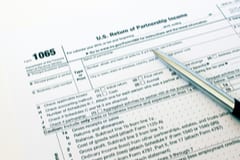Filing Form 1065: What Partners Need to now to report income
5 min read
January 17, 2025 • Block Advisors
Forming a partnership can have its advantages for your small business. It also means different tax preparation responsibilities and IRS guidelines.
As pass-through entities, Partnerships report their adjusted gross income, tax deductions, and credits to partners. Partners, in turn, report those items on their personal tax returns. The partnership will also file one partnership return for information purposes on Form 1065. In fact, one partner is designated to sign on behalf of the partnership. Each partner will then also report individually on their Form 1040.
Whether you have a current or aspiring partnership, you can learn more about filing Form 1065 here!
Need help navigating partnership taxes?
Our Small Business Certified Tax Pros have got your back.
What is Form 1065?

Form 1065, U.S. Return of Partnership Income, is used to report your partnership’s income, gains, losses, deductions, credits, and general business information to the IRS.
You won’t determine how much tax is owed on this form – that happens as items on a Schedule K-1 (Form 1065). Each partner will report the partnership tax liability on their personal tax return. That’s where the “pass-through” part mentioned above comes in.
How do Form 1065 and Schedule K-1 work for partnerships?
Think of it this way–if four individuals form a partnership, Form 1065 outlines the business’ reportable activity as a whole. Then, each of the four partners will receive their own Schedule K-1 (Form 1065) to report their personal share of each category (income, gains, losses, deductions). The Schedule K-1s are prepared together with the 1065 partnership. Then, the partnership issues the K-1s to its partners.
Who is required and has to file Form 1065?
This tax form is filed by:
- Partnerships, including general, limited partnerships, and limited liability partnerships
- A Limited Liability Company (LLC) with multiple members that haven’t elected to be taxed as a corporation or S corporation
- Foreign partnerships with income in the United States
Other types of entities, such as nonprofit section 501(d) religious organizations and joint ventures, may also have a Form 1065 filing requirement.
How to fill out Form 1065
Wondering how to fill out Form 1065? This form is five pages long. We’ve created a summary of each page so you can better understand what information is required. But if these details are a cause of stress, we get it.
When it comes to tax time, you want to get everything right. Luckily, you don’t have to worry about completing Form 1065 or your Schedule K-1s alone. By working with a Block Advisor certified small business tax pro, you can return to running your business and leave the paperwork to us.
Still interested in what’s covered in Form 1065? Read on.
Page one:
Page one of the IRS Form 1065 should include:
- Basic information–your partnership’s name, address, employer identification number, business activity, date that the business started
- Whether the return is special (i.e., initial return, final return, amended partnership return, etc.)
- Method of accounting
- The number of Schedules K-1 attached
Income:
Page one of the 1065 Form also includes a section where you list all income, deductions, tax liability, and payments coming from your partnership’s trade or business, such as:
- Net gain or loss
- Gross receipts or sales
- Income generated from business assets
The bottom of page one of the 1065 tax form has an area where any partner can enter their signature.
Pages two and three:
Pages two and three list Schedule B, Other Information. You’ll answer a list of yes or no questions regarding specific situations. These two pages are also used to provide information about a central point of contact—someone designated by the partnership to:
- Act on behalf of the partnership under the centralized partnership audit regime.
- Work with the IRS on matters concerning the return and whether the partnership is opting out of the new centralized audit rules.
Page four:
Page four of Form 1065 lists Schedule K, the partners’ distributive share of items. It has sections for:
- Income and losses
- Tax deductions
- Self-employment
- Tax credits
- Foreign transactions
- Alternative minimum tax items
Page five:
Page five of Form 1065 breaks down the business’ income or loss.
It also divides the income or loss among general partners and limited partners, and by the type of partner.
There are three schedules listed on page five: Schedule L, Schedule M-1, and Schedule M-2.
- Schedule L is a balance sheet for the partnership’s assets, liabilities, and capital.
- Schedule M-1 shows a reconciliation of income or loss with information reported on the partnership’s books. This will show you the difference between book and tax accounting since the two are often different.
- Schedule M-2 is an analysis of the partners’ capital accounts.
- The partnership also might be required to file Schedule M-3 instead of Schedule M-1 if specific requirements are met. See the Instructions for Form 1065 for more information.
When is IRS Form 1065 due?
The Form 1065 is due on the 15th day of the 3rd month after the end of the partnership’s tax year. If your year ends on December 31, the due date is March 15 or the next business day if that date falls on a weekend.
More help with Form 1065 and business tax preparation
Being a small business owner comes with many tax nuances. If you need help filing taxes on behalf of a partnership, get help from the pros.
A Block Advisors small business certified tax professional can handle the details and file your small business taxes for you. Need help beyond taxes? Our experts can also help with bookkeeping and payroll throughout the year.
This article is for informational purposes only. The content may not constitute the most up-to-date information and should not be construed as legal advice.




